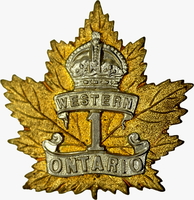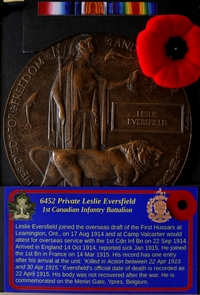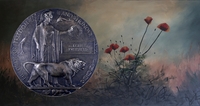
6452 Private Leslie Eversfield
1st Canadian Infantry Battalion
By: Capt (ret'd) Michael M. O'Leary, CD, The RCR
Leslie Eversfield was born in Manchester Square, London, England on 22 Jun 1891. His father was Harry Eversfield (1866-1896) and his mother was Eva Eversfield (nee Boucicault) (1857-1909).
Having emigrated to Canada before the First World War, Eversfield was working in south-western Ontario in the summer of 1914. At the outbreak of the war, he joined the overseas contingent of the First Hussars, a cavalry regiment of the Canadian Militia headquartered at London, Ontario. Enlisting on 17 Aug 1914 at Leamington, Ontario, Eversfield traveled with this unit's draft to Valcartier where he would to join a unit of the First Canadian Contingent.
Eversfield attested for overseas service in the Canadian Expeditionary Force (C.E.F.) with the 1st Canadian Infantry Battalion at Camp Valcartier, P.Q., on 22 Sep 1914. A 23-year-old florist (also recorded as horticulturalist), Eversfield was described on his attestation paper as 5 feet 9 1/2 inches tall, weighing 145 pounds, with good physical development, a 38-inch chest, a fair complexion, blue eyes, and brown hair. Eversfield's medical examination did note swelling of the knuckles on both fourth fingers. His religious denomination was Roman Catholic. Eversfield identified his grandmother, Mrs. A. Boucicault, of 6 Wellington Square, Kings Rd., Chelsea, London, England, as his next of kin. On attesting with the 1st Battalion, Eversfield was given the regimental number 6452.
The 1st Cdn Inf Bn sailed for England from Quebec aboard the S.S. Laurentic on 3 Oct 1914. The unit arrived in England on 14 Oct 1914 with 45 officers and 1121 men. When the 1st Canadian Division went to France in early February, 1915, Eversfield remained in England with the Base Company which would initially provide reinforcements to the unit.
Eversfield would not join the 1st Battalion in the field as a reinforcement until 12 Mar 1915.
On 28 Jan 1915, Eversfield reported sick and was admitted to the 4th London General Hospital. He was diagnosed with rheumatism and suffering from slight pains in both knees. Discharged to duty on 31 Jan 1915, Eversfield was transferred to the 9th Canadian Infantry Battalion at Tidworth on 15 Feb 1915. he would remain with the 9th Bn. for less than two weeks, and be transferred back to the 1st Battalion's Base Company, also at Tidworth, on 26 Feb 1915.
Eversfield was sent overseas to France as a reinforcement for the 1st Cdn. Inf. Bn. on 11 Mar 1915. The following day he was transported from Rouen to join the unit. The unit's War Diary notes the arrival of seven men as reinforcements on 14 Mar 1915 as the unit went into Divisional Reserve.
Eversfield trained with the 1st Battalion, sailed to England, and entered France after the unit as a reinforcement. Little of the early months of his service is detailed in his service record. His record has one simple entry on the record of service sheets after his arrival at the unit: "Killed in Action between 22 Apr 1915 and 30 Apr 1915."
That simple note indicates how pressed the Battalion, as part of the 1st Canadian Infantry Division, was during those critical days of April 1915. Starting with the first German gas attack on 22 April and the 1st Battalion being thrown into the line to stop the very nearly successful German breakout, it was not even possible for the survivors to establish exactly when Eversfield fell in combat.
The so-named "Battle Bar Ledgers" prepared after the war by the Department of Defence (in anticipation of clasps being issued for the British War Medal) provides the following outline for the 1st Battalion's activities in late April, 1915:
- March
- 10-13 Mar 1915; Forward Line of Troops (No. 5 Sub-Section)
- 14-17 Mar 1915; Divisional Reserve (RUE DEL PIERRE) STOOD TO ARMS during this tour for British operations at NEUVE CHAPELLE
- 18-21 Mar 1915; Forward Line of Troops (No. 5 Sub-Section)
- 22-25 Mar 1915; Brigade Reserve (LA TOULETTE)
- 26 Mar; to new billets (Sheet 36A, L.0.a.7.8)
- 27 Mar to 6 Apr; training
- April
- 6th; to OUDERZEELE
- 6th to 17th; training at OUDERZEELE
- 18th; to PROVEN
- 20th; to VLAMERTINGHE
- 21-22 Apr 1915; Divisional Reserve (VLAMERTINGHE Sheet 28.NW H.2.a Trenches)
- 23 Apr 1915; Forward Line of Troops, Supporting attack by French Army on PILKEM VILLAGE.
- 24-25 Apr 1915; Local Support, In attack on ST JULIEN.
- 26-28 Apr 1915; Local Support, In support holding YSER CANAL
- 29-30 Apr 1915; Divisional Reserve (VLAMERTINGHE Sheet 28.NW H.2.a Trenches)
The War Diary of the 1st Canadian Infantry Battalion for April 1915 provides a "Narrative of Operations, 23rd to 30th April 1915." This narrative reads as follows:
"FIRST CANADIAN BATTALION.
"Narrative of operations 23rd to 30th April, 1915.
Ref. Sheet 28, 1/40,000
"On the morning of the 23rd April at 1.40 A.M. The 1st and 4th Canadian Bns moved from VLAMERTINGHE via BRIELEN and crossed the YSER CANAL—4th Battalion leading.
"These units then occupied a position on the east side of the CANAL facing NORTH along the track leading EAST from the bridge (Pontoon No. 4) 500 yards south of the first bend in the CANAL north of YPRES. This position extended from the YPRES—PILCKEM road, inclusive, to the CANAL. Th 4th Canadian Battalion was on the right.
"Col. GEDDES, the Buffs, with 3 Bns. was expected to advance through the position occupied to the NORTH.
"At 5 A.M. the Canadian Bns. were ordered to attack in the direction of PILCKEM village with their left resting on the YPRES—PILCKEM road supporting an attack by the FRENCH on their left and to maintain contact with Col. GEDDES' force on their right. The 4th Bn was directed to lead the advance, the 1st Bn supporting.
"The ridge 1200 yards SOUTH of PILCKEM was occupied by the enemy and was the first objective.
"The attack was launched under heavy artillery, machine gun and rifle fire and without artillery preparation. The only artillery support was afforded by one Batty in rear.
"On our advance the enemy retired from some advanced trenches he had occupied to his main position on the ridge.
"At 9:30 A.M. after reaching a point 500 yards from the crest of the ridge the attacking force was ordered to halt and entrench.
"At 3:48 P.M. the FRENCH advanced to attack on our left and at the same time Col. GEDDES' force advanced through our entrenched position. The Canadian Bns, went forward with this force leaving a sufficient garrison in the entrenched position already gained.
"In support of this position the local reserve of the 1st Canadian Bn, had in the morning thrown up a a strong line of trenches facing PILCKEM ridge on the high ground near the track leading from the CANAL bridge.
"The afternoon attack reached a point within 200 yards of the enemy's main position on the ridge but being too thin and insufficiently supported by artillery the attack failed to gain its objective, but the ground gained was held.
"At 11:50 P.M, the advanced troops were relieved and the 1st Canadian Bn was ordered to occupy the line of trenches constructed by the local reserve in the morning and act as a reserve to the front line. This position was held until 7 P.M. the 24th inst. under very heavy artillery, machine gun and rifle fire.
"During the morning 24th inst. the FRENCH developed an attack on our left which was unsuccessful but some ground was gained.
"At 7 P.M. the 24th inst, the 1st Canadian Bn, was ordered to march towards FORTUIN via WIELTJE and on reaching a point 200 yards south of FORTUIN entrenched facing NORTH, supporting an attack on ST. JULIEN.
"The Bn remained in these supporting trenches under heavy fire until 8 P.M. the Bn, was withdrawn and marched to the west bank of the YSER CANAL at PONTOON bridge No. 4—the point of crossing on the 23rd inst. and occupied a position covering the ground between the 3rd and 5th PONTOON BRIDGES. This position mas maintained under heavy artillery fire until the evening of the 28th inst.
"At 6:80 P.M, the 28th inst. the Bn with the remainder of the 1st Canadian Inf. Bde crossed the canal road constructed a line of trenches between the farms C22a and C22b and also assisted the Rifle Bde in building and repairing their trenches, later withdrawing to VLAMERTINGHE.
"The casualties suffered during the period 23rd to 30th inst. were: officers—killed 3, wounded 7; other ranks—killed 58, wounded 306, missing 34. Nearly all these casualties occurred on the 23rd inst.
"The conduct of all ranks was all that could possibly be desired and their devotion to duty and steadiness remarkable.
"F.W. Hill
Comdg., 1st Canadian Battalion
"1 May 1915"
The 1st Canadian Infantry Battalion was awarded three Battle Honours for actions covering April 1915. These Battle Honours are now carried by The Royal Canadian Regiment, which perpetuates the 1st Canadian Infantry Battalion.
- Ypres, 1915 (22 April – 25 May 1915)
- Gravenstafel Ridge (22-23 April 1915)
- St Julien (24 April – 4 May 1915)
Among the 1st Battalion's casualties during those operations was Private Leslie Eversfield. His body was never recovered and identified. Leslie Eversfield was formally recorded as "Killed in Action between 22 and 30 Apr 1915." This was only his second time in the forward lines of trenches and in stark comparison to 18-21 March during which the unit noted only three killed in action.
Eversfield's official date of death is recorded as 22 April 1915. Eversfield's Circumstances of Death record sheet held by Library and Archives Canada notes "Killed in Action" and gives a location only as "Vicinity of St Julien." This information would place his date of death as most likely being 24 or 25 April 1915. The Circumstances of Death form notes also that there was a battlefield burial of his remains at map location Sheet 28.c.20.c.6.5. the form stated that he was "Buried with eighteen others in same grave near Shrine beside Ypres-Pilkem Road." Sadly, Eversfields body was not recovered after the war. He is commemorated on the Menin Gate, Ypres, Belgium.
On 10 May 1915, the London Advertiser (a daily newspaper in London, Ontario) published Eversfield's name in the casualty list received that day. The 17 May 1915 edition of the paper carried the following item:
"Leamington Recruit is Killed in Action
"Leamington, May 16—Leamington has learned the loss of one of the town boys who enlisted in the 1st Battalion. Leslie Mark Eversfield has been reported killed in action in Flanders. Eversfield was a grandson of the celebrated Irish actor, Dion Bousicoult (sic), and his father was also an actor. He had lived for some time in Ruthven."
Following the death of Eversfield's grandmother, his next of kin recorded in his service record change to his uncle: Dion Boucicault, 4 Wyndham Place, Bryanston Sq. W.1, England.
For his service in the CEF, Eversfield was entitled to receive the 1914-15 Star, British War Medal and the Victory Medal. These were despatched to his uncle on 27 Jul 1921. Dion Boucicault would also receive the Memorial Plaque and Scroll commemorating Eversfield's death. The plaque would be despatched on 18 May 1922. Since Eversfield was unmarried, and his mother had predeceased him, no silver Memorial Cross would be issued.

Leslie Eversfield's story of CEF service would be all too common. Enlistment, training, reaching the front and within a few short weeks or months, killed in action with no known grave. There is almost no trace of Eversfield in readily available documents, but the names of his next-of-kin readily lead us to explore his family history.
Grandfather: Dion Boucicault (1820-1890)
Born Dionysius Lardner Boursiquot but commonly known as Dion Boucicault, was an Irish actor and playwright famed for his melodramas. Well-known on both sides of the Atlantic as a highly successful actor, playwright, and manager in English-speaking theatre. His influence in changing the Irish mein in theatre was summarized by E.B. Cullingford in 1997: "English dramatists created the drunken, stupid, and violent Stage Irishman; the Irish dramatist Dion Boucicault reinvented him as drunken, clever, and charming; …"
The elder Boucicault wed three times. His first wife died in a Swiss mountaineering accident the same year they married. He had six children by his second wife, and he married the third under accusations of bigamy as he had eloped with his latest love interest, abandoning his second wife. Boucicault died in 1890 in New York, having lost the rights to many of his plays to finance alimony payments.
"BOUCICAULT, DION (1820?–1890), originally called Bourcicault, actor and dramatist, was born in Dublin on 26 Dec. 1820 (or by other accounts on 20 Dec. 1822).
"…In 1876 he retired to America, where, after repudiating his wife and making other so-called nuptial arrangements, casting on his children an unmerited stigma, he died 18 Sept. 1890. Two sons of Boucicault and two daughters are, or have been, on the stage. One daughter married John Clayton (1843–1889) [q. v. Suppl.] Mr. Dion Boucicault, jun., was concerned with the management of the Court Theatre, …" – (https://en.wikisource.org/wiki/Boucicault,_Dion_(DNB01))
Grandmother: Agnes Kelly Boucicault (nee Robertson) (1833-1916); "The Second Wife"
Born in Edinburgh and a popular actress on both sides of the Atlantic, Agnes would elope with and marry Dion Boucicault in 1853. She would divorce him in 1888. the couple would have six children:
- William Dion William
- Eva (or Eve) Boucicault
- Darley George ("Dot") Boucicault, later known as Dion Boucicault the Younger (an actor, manager and stage director who married actress Irene Vanbrugh)
- Patrice Boucicault
- Nina Boucicault (an actress)
- Aubrey Boucicault (an actor and writer)
Mother: Eva Boucicault (1857–1909)
Eva is the Boucicault daughter who is almost invisible in searchable sources. She married John Alfred Clayton Calthrop, known as John Clayton (1843–1889) in 1877, a marriage without the consent of the bride's family. They would have four children; Dion (b. 1878), Dorothy (b. 1880), Ian (b. 1884), and Donald (b. 1888). A page on ancestry.com described the end of their marriage as "Eve had left him for Harry Eversfield, an actor and his secretary, but returned to him when he was critically ill."
After John Clayon's death, Eve married Harry Eversfield in 1890 in London, Eng. Various sources note that by 1896 the couple had two children, Dion Richard Eversfield (1895–1898) and a second child who isn't named in Eva's or Harry's ancestry pages. One source adds the details that Eva was "left with two children, one four years old and the other ten months old." The younger child would have been Dion, and the older child, born about 1891, would have been Leslie Eversfield.
Father: Harry Eversfield
Harry Eversfield was a rising star of the stage when he enticed Eva away from her husband John Clayton. He died of a morphine overdose in 1896, leaving his wife with two small children. His death was a highlight of the society and gossip pages of the day and excerpts from these give some hints of the lives the couple lived.
I. "Mr. Harry Eversfield, best of stage boys, succumbed at New York on February 6 to an overdose of morphine. He was married to the widow of John Clayton (Miss Eve Boucicault.)" – Theatre, Volume 27, March 1, 1896
II. "Mr. Eversfield, who died from an overdose of morphine, married the widow of Mr. John Clayton, the lady being a daughter of the late Dion Boucicault." – Sketch: A Journal of Art and Actuality, Volume 13
III. "From my heart I wish that yet another kindly wire would come to assure me that the news of young Harry Eversfield's death was false as well. But I fear that is beyond all hope. He was a bright, cheery young fellow, and, though not particularly versatile, a very capable actor. His principal successes were made at the Court Theatre in the old days, and he enjoyed the friendship and confidence of one of the managers, John Clayton. Ultimately he married Clayton's widow, who was a daughter of the late Dion Boucicault. She has been left with two children, one four years old and the other ten months old, in very straitened circumstances, for Eversfield was just a trifle inconsequent and irresporsible, and though he got a good salary—he was playing in one of George Edwardes' American companies—it was light come, light go, with him; and since the first week in December he sent home no more than four pounds to his wife. Her mother, Mrs. Dion Boucieault, who is now playing in The Colleen Bawn at the Princess's, broke the news of his death to her, and the task was doubly difficult, since the first telegrams announced that it was a case of suicide by morphia on the part of "Mr. and Mrs. Harry Eversfield." Amongst the company at the Olympic, where Mrs, Eversfield was playing a very small part in Cheer, Boys, Cheer, the deepest sympathy is felt for her, and steps have heen taken to organise a benefit on her behalf. Sir. Augustus Harris has generously offered every facility, and anyone wishing to help with subscriptions, or in any other way, should communicate immediately with mr. Henry Neville at the Olympic Theatre." – The Ruminations of Randolph, February 15, 1896
IV. "Harry Eversfield, thirty years old, an actor who played the part of Algernon St. Albans in "The Artist's Model." at the Broadway Theatre, died last night in the Warwick Hotel, Fortieth Street and Broadway, from morphine poisoning. Eversfield did not appear at the theatre last night, and after waiting for him for some time, the stage manager, Herbert Cathcart, sent a call boy to his room at the hotel to tell him he was overdue at the theatre. The boy knocked on the door several times, but received no response. He then opened the door and entered. He found Eversfield on his bed partially dressed. He spoke to Eversfield, but received no answer. The call boy noticed that the actor was breathing heavily, and shook him violently until he was aroused. Eversfield got out of bed and told the boy that he would be at the theatre in a few seconds. The boy returned to the theatre and told the stage manager of the actor's condition. Mr. Cathcart at once summoned Dr. Fred Goodwin of 220 West Forty-second Street, who went to the hotel and found the actor lying unconscious on the bed. He discovered that the actor's condition was extremely critical, the pulse being scarcely perceptible, and the heart beats faint. Despite the Doctor's efforts to revive him, the actor died one hour later. Eversfield had been suffering from insomnia for several weeks, and a Dr. Kolb had prescribed morphine. A large bottle of the drug was found beside the actor. It was almost filled. This fact led the police to believe that the actor had accidentally taken an overdose of the drug. Eversfield had been on the stage since he was twelve years old. He appeared in this country in the original Gaiety company, with Fred Leslie and Letty Lind. He was married about twenty years ago to Miss Amy Boucicault, daughter of Dion Boucicault. His wife and two children live in England. Mrs. Eversfield was notified by cable of her husband's death." – New York Times, 7 Feb 1896
Uncle: Dion Boucicault Jr. (born Darley George Boucicault; 1859–1929)
Leslie Eversfield' uncle, Dion Boucicault, was named as next of kin to Leslie after the death of Agnes Boucicault.
DISTINGUISHED THEATRICAL FAMILIES - Mr. Dion Boucicault, who, with his brilliant wife. Miss Irene Vanbrugh, is now appearing in Somerset Maugham's comedy, 'Caroline,' at the' King's Theatre, Melbourne, is the most distinguished of a family of four, all the members of which were on the stage. His brother, Aubrey died in 1913, and his sister, Nina, well remembered in Australia towards the close of last century, married E.H. Kelly, an actor, and was herself celebrated for her performance as Kilty Verdun in the first production of 'Charley's Aunt.' Miss Eva Boucicault, the remaining member of the family married John Clayton Calthrop, who died in 1888. Her two sons, Donald and Dion Clayton Calthrop, are famous in the theatrical world—Donald as an actor, and Dion as an artist and dramatist. Dion Calthrop collaborated with Harry Graham in the production of 'A Southern Maid.' - Chronicle (Adelaide, SA) Sat 5 Nov 1927 (dated info used?)
In all the mentions of the Boucicault lineage found in newspapers and other published sources, none mention leslie Eversfield except in passing mention of two children left with Eva by Harry Everfield's death. We may never know how Leslie came to be working as a horticultualist in south-western Ontario by 1914 and serving in the 1st Canadian Infantry Battalion. Unlike so many of his family who established themselves on stage and in the history of English-speaking theatre, Leslie Eversfield's lasting legacy will ever be his name engraved on the Menin Gate at Ypres, Belgium.
Pro Patria
Visit a randomly selected page in The O'Leary Collection (or reload for another choice):
- The O'Leary Collection; Medals of The Royal Canadian Regiment.
- Researching Canadian Soldiers of the First World War
- Researching The Royal Canadian Regiment
- The RCR in the First World War
- Badges of The RCR
- The Senior Subaltern
- The Minute Book (blog)
- Rogue Papers
- Tactical Primers
- The Regimental Library
- Battle Honours
- Perpetuation of the CEF
- A Miscellany
- Quotes
- The Frontenac Times
- Site Map
QUICK LINKS
The O'Leary Collection—Medals of The Royal Canadian Regiment
Newest additions:
![]()
![]() SB-12725 Private Henry "Hank" Ard
SB-12725 Private Henry "Hank" Ard ![]()
WIA at Hill 187, Died of Wounds in Japan
![]()
![]() 2355331 Lance Corporal Albert Lorking
2355331 Lance Corporal Albert Lorking
Wounded in action, later a War Amps representative.
![]()
![]() 4334 / 477996 Pte Isaac Hamilton Wilcox
4334 / 477996 Pte Isaac Hamilton Wilcox
Permanent Force, South Africa, and C.E.F.
![]()
![]() 477019 Private Harold Ashcroft
477019 Private Harold Ashcroft
Transferred to the Tunnelers.
![]()
![]() 734231 Private Clark D. Thompson
734231 Private Clark D. Thompson ![]()
The older Thompson brother, killed in action.
![]()
![]() 733849 Private Norman Parker Thompson
733849 Private Norman Parker Thompson
The younger Thompson brother; post-war service in the Special Guard.
![]()
![]()
![]() A305 / 400305 Private Andrew Walker
A305 / 400305 Private Andrew Walker ![]()
"Previously reported Wounded, now Killed in Action."
![]()
![]() 823298 Pte Thomas Patrick Steele, M.M.
823298 Pte Thomas Patrick Steele, M.M. ![]()
… for gallant conduct in the field …
![]()
![]() P13066 Sergeant Harold Thompson
P13066 Sergeant Harold Thompson
Instrumental Soloist for over 20 years of Canadian Army service.
![]()
![]() 9609 / 477728 Private Albert Edward Piper
9609 / 477728 Private Albert Edward Piper
"Arrived from England as a STOWAWAY …"




